ou can hurt with your words but sometimes you can hurt more with your silence.
Wednesday, April 28, 2010
Tuesday, April 27, 2010
What’s in Naga? Answer: Banana Cue and Kamote Cue
Have you ever lusted for some old-time ‘comfort street food’? Well I have, when I was in Cebu in October this year. My taste buds were desperately yearning for a stick of fried banana cue (caramelized banana) and some fried kamote cue (caramelized sweet potato) as well, but how come these street delicacies were nowhere to be found in the city?

I am honestly fearing the (imminent?) banana cue sold on the streets tradition extinction so kindly pass this on to all the ‘manangs’ and ‘alings’ out there... please, please, please... do not tire from deep frying these yummy caramelized treats at corner streets and at sari-sari stores. As for you, the local Filipino consumer: Buy Filipino! Buy banana cue, buy kamote cue and help preserve Filipino street food culture.
And because I was still craving, we all hopped in the car and went to Naga, just to buy banana and kamote cues. Yipee!
I took a few fotos of the environs there as well, see them below. The rest of the fotos are all here: Naga, Cebu - Philippines


Banana Cue street vendor.


Kamote Cues, YUMMY.


Tricycad drivers and three little boys in a tricycad.


Market scene in Naga, Cebu.


Naga Catholic Church and the old Naga City Hall (there is a brand spanking new modern and big city hall building at the back).


Oil tanker ships along Naga coast and a woman bathing on the rocky coast.


Siomai stands on Naga boulevard seems to be more popular than banana or kamote cues. Next foto, English translation: Do not pee here.

I am honestly fearing the (imminent?) banana cue sold on the streets tradition extinction so kindly pass this on to all the ‘manangs’ and ‘alings’ out there... please, please, please... do not tire from deep frying these yummy caramelized treats at corner streets and at sari-sari stores. As for you, the local Filipino consumer: Buy Filipino! Buy banana cue, buy kamote cue and help preserve Filipino street food culture.
And because I was still craving, we all hopped in the car and went to Naga, just to buy banana and kamote cues. Yipee!
I took a few fotos of the environs there as well, see them below. The rest of the fotos are all here: Naga, Cebu - Philippines


Banana Cue street vendor.


Kamote Cues, YUMMY.


Tricycad drivers and three little boys in a tricycad.


Market scene in Naga, Cebu.


Naga Catholic Church and the old Naga City Hall (there is a brand spanking new modern and big city hall building at the back).


Oil tanker ships along Naga coast and a woman bathing on the rocky coast.


Siomai stands on Naga boulevard seems to be more popular than banana or kamote cues. Next foto, English translation: Do not pee here.
The Estate of John Rupert :: Goods and Chattels
The will of John Rupert dated October 17, 1828 was admitted to probate in Columbiana County, Ohio in August of 1831. The appraisers were appointed on September 3, 1831 and an inventory was submitted to the executors on that date. These documents are of importance because they place John Rupert in Hanover township. I'm not sure that this is a complete inventory, because the sale bill seems to have more items. It is possible that some pages were missing when the estate papers were microfilmed.

Appointment of Administrators of the estate of John Rupart. Packet 1439. Family History Library microfilm 2032592.
State of Ohio
Columbiana County
Before me Michael Arter a Justice of the peace in and for said county personally came Philip Andrew Peter Guisinger David Wiley appraisers of the estate of John Rupert late of Hanover Township in said county deceased and were sworn well and truly to apprais all the goods and Chattles of said estate which shall be presented to them for appraisement, and also to set off to the widow of said deceased such possessions or other property as they shall think reasonable for the support of herself and children twelve months from the time of the death of the said deceased.
Given under my hand this 3d day of September 1831
Michael Arter Justice of the peace

Inventory of the estate of John Rupart. Packet 1439.
“A true and accurate inventory of the goods and chattels of the estate of John Rupert late of Hanover township, deceased presented to us the undersigned appraisers of said estate, by Conrad Yarien & David Ehrhart, executors thereof, the 3d day of September 1831.”

Appointment of Administrators of the estate of John Rupart. Packet 1439. Family History Library microfilm 2032592.
State of Ohio
Columbiana County
Before me Michael Arter a Justice of the peace in and for said county personally came Philip Andrew Peter Guisinger David Wiley appraisers of the estate of John Rupert late of Hanover Township in said county deceased and were sworn well and truly to apprais all the goods and Chattles of said estate which shall be presented to them for appraisement, and also to set off to the widow of said deceased such possessions or other property as they shall think reasonable for the support of herself and children twelve months from the time of the death of the said deceased.
Given under my hand this 3d day of September 1831
Michael Arter Justice of the peace

Inventory of the estate of John Rupart. Packet 1439.
“A true and accurate inventory of the goods and chattels of the estate of John Rupert late of Hanover township, deceased presented to us the undersigned appraisers of said estate, by Conrad Yarien & David Ehrhart, executors thereof, the 3d day of September 1831.”
| one man's saddle - - 1.00 one wheel & Reel - - 2.50 one churn - - 1.00 one shovel, axe, &c. - - 2.00 one [?] kettle [?] - - 1.50 a lot of chissels - - 0.25 a lot of Iron, &c. - - 0.75 one hammer, anvil, &c. - - 0.50 one Kettle - - 1.50 one Scythe - - 0.37 ½ one Salt barrel - - 1.25 a lot of tubs and barrels - - 1.50 a lot of Tubs - - 0.75 a lot of Cradles [?] - - 0.75 A lot of Tubs - - 0.12 ½ A lot of Corn - - 0.25 One heiffer - - 6.00 one windmill - - 5.00 one dunghook & pitchfork - - 0.37 one Salt barrel - - 0.12 ½ A lot of wheat – 10.00 a lot of rye - - 3.25 A lot of oats – - 2.25 A quantity of Hay - - 4.00 Shovel & tongs - - 0.50 Two pot racks - - 1.50 one clock - - 2.50 one Cooking glass - - 0.50 a pair of Cards [?] - - 0.25 one chest - - 1.00 one table - - 1.00 a pair of irons - - 0.50 one bed - - 4.00 | Dresser ware - - 4.00 one iron pot, $c. - - 2.50 Pewter ware - - 3.00 4 Chairs - - 0.50 one Cow bell - - 0.75 A quantity of Rye - - 2.50 a tub of wheat - - 2.00 2 barrels - - 0.25 7 bags - - 2.00 Corn in the ground - - 5.00 Cow Chains - - 1.00 Half bushel, &c &c - - 1.37 ½ A ½ pair of Steelyards - - 0.75 one griddle - - 1.00 one adze and basket - - 0.50 one spinning wheel - - 1.00 one trunk - - 0.16 ¼ one Rig [?] - - 0.50 one hackle - - 1.00 Cash on hand - - 12.12 ½ Philip Andrew David Wiley Peter Guisinger |
Monday, April 26, 2010
Ziva & Wiley
Sunday, April 25, 2010
Holley, NY to Lebanon, PA and Low Bridges
 Today we left New York and started our journey back south. We landed in Lebanon, PA and are staying at the Thousand Trails there.
Today we left New York and started our journey back south. We landed in Lebanon, PA and are staying at the Thousand Trails there.Since we just left the Erie Canal, Low Bridge Everybody Down has been a line from a song we've been singing. It also translates into our lives so often when we are traveling. Today we had to turn around in someone's driveway when we met up with a low bridge. Only to come in contact with another within minutes.
I've had people ask us, what do you do when you get to a low bridge? So I decided to document it to show you. This is what happens when you are not sure if you'll make it. You get out and watch to see if you'll make it or not. In this case Austin goes to the front of the truck and I'm sort of in the back, meaning I'm taking pictures while watching the back.

 We were good, except for the heat pump unit which was a little too close for my comfort. We made it through though and were good to go. Oddly enough, this is normal for us to stop and get out of the truck and do this. I'm sure others don't quite see it that way though!
We were good, except for the heat pump unit which was a little too close for my comfort. We made it through though and were good to go. Oddly enough, this is normal for us to stop and get out of the truck and do this. I'm sure others don't quite see it that way though!
Thursday, April 22, 2010
Not a Typical DL-1
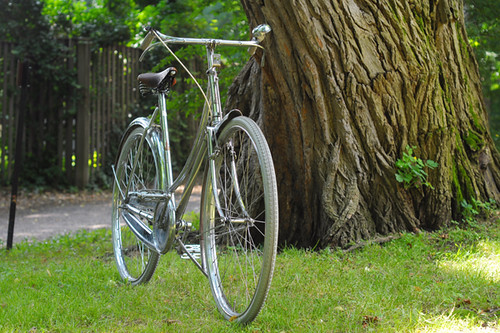
Over the years I've been fortunate enough to befriend some very serious bicycle collectors. And I understand enough about how they operate to know it is unlikely that I will ever be one of them. I have a strong aversion to online auctions. I am unwilling to spend my weekends traveling across state lines to visit bike swaps and barn sales. Space is an issue. Andmost importantly, my tastes in bikes are too varied. But if there is one bicycle in which my interest has remained consistent, it is the Raleigh DL-1 Lady's Tourist.
I acquired my first one in - a run of the mill 1973 model in so-so condition - and "frankenbiked" it into a working city steed which I still ride today. The second Lady's Tourist was practically forced into my hands half a year later. The 1930s model was covered in surface rust and I did not want it. Where would I keep the filthy thing? But the gentleman who offered it insisted I was the rightful owner: "Take it. It is completely intact and that rust can be removed. You won't regret it." He was correct. It is a historically significant treasure that I look forward to carefully restoring some day.
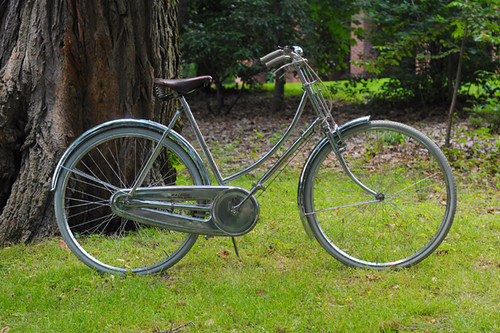
At that point I knew that I would have a collection of DL-1s in the future; it was just a matter of time and luck. I did not intend to buy up random Raleigh Tourists; I was interested in specific things.An all-original model from the 1940s-50s was one of them. A pre-1930s model was another. And then there was the one that seemed least likely to surface: the chrome Tourist. But two years later, surface it did - in the hands of a collector in Germany, who did not want it for himself and promptly offered it to me. I was not prepared, but a chance like this does not come along often and after a feverish correspondence the bike was mine. The machine arrived completely disassembled and packed into a standard sized box in the most expert manner I've ever seen. It took us some time to put it back together, but finally we managed and here it is: a chromeRaleigh DL-1 Lady's Tourist.
The proportions of the 22" frame are identical to my 1973 bike. The hub is stamped 1980. "Raleigh Nottingham" headbadge. Most of the parts are original. The amount of wear suggests the previous owner rode it for years on a regular basis, but did not store it outdoors.
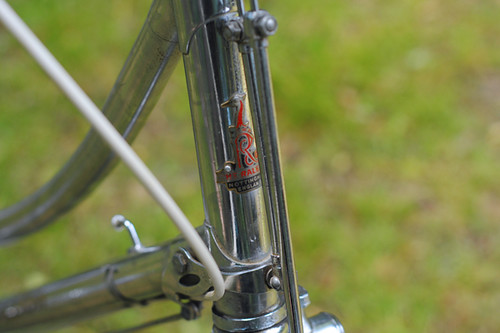
Aside from their eye-catching finish, what makes chrome DL-1s interesting is that historically they are somewhat of an enigma. On several occasions, Raleigh released limited edition All-Chrome versions of their roadster models. Originally these were made only for dealers as demos or display models. In later decades chromed editions began appearing in catalogues.In theory it is possible to find a chromed Raleigh roadster from any number of decades, made for any number of markets. The best known of these today is the Boss Bike - a balloon tire chromed Superbe Roadster produced for Raleigh's African market in the 1970s. There was also a chromed DL-1 produced for the German market through the late 1970s and early '80s. My bike is an example of the latter.

One very cool thing about the bike is the locking fork. Unfortunately, the key is missing. I will look into whether it's possible to get a duplicate made.
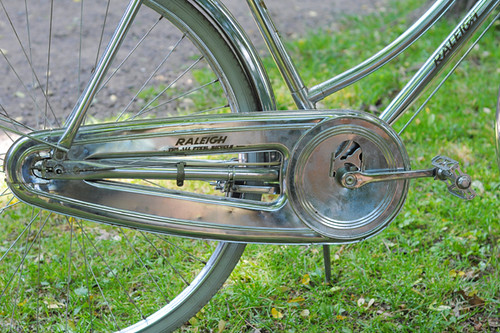
Also missing is the observation insert on the chaincase. The rear of the chaincase is slightly crumpled, but we are working on fixing that. The bike needs new cotters, and the headset could use repacking or replacing. Otherwise there is no damage.

A couple of things are not original, such as these newer tires (which ride great). The headlight and bottle generator are missing, though I do have the original tail light.
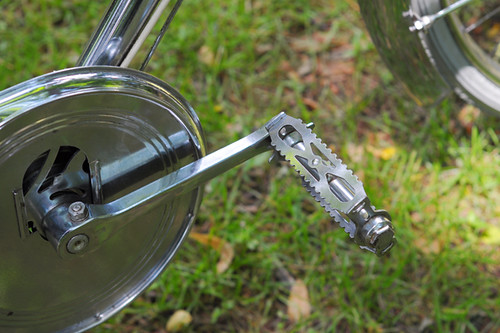
I initially thought these pedals were not original, but have since seen similar ones on other chromed Raleighs. The seller sent me these along with a set of the more typical Raleigh platform rubber pedals, but these are nicer and less than half the weight.

It looks like the grips were replaced by the previous owner after the originals wore out. The fit isn't quite right, but they feel and look fine, so I will keep them until I can find a better alternative. Late 1970s - early '80s Sturmey Archer trigger shifter.

The bolted rear triangle and fork ends are identical in design to my standard 1973 DL-1.
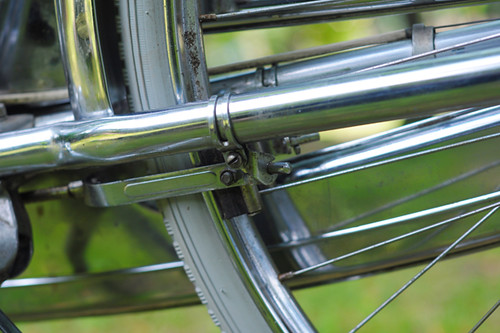
The rod brakes, however, are a little different. I need to take close-ups of the other bike for a comparison. They need new brake pads, but work reasonably well in the meantime. The rear one is stronger than the front.

My understanding is that originally these bikes came with Brooks B33 saddles, but it was missing here. The seller included a spare from his personal collection, which is a brown Brooks "Champion B66 S.T.R." This is a long-nosed men's saddle, most comparable to today's Flyer model. I would love to get a shorter nosed model for this bike, and if anyone would like to trade let me know.
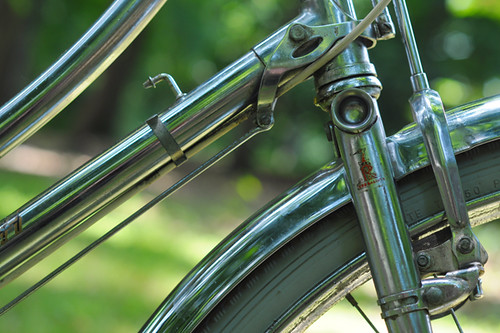
I am still just getting to know this bike and not sure what I will do with it in the immediate future. Putting it in storage was my plan, but I rode it and it feels too nice to put away just yet.

For now I will get the cotters replaced and see what else needs adjusting. There is a local vintage bike show coming up in August and I might take it there if the timing works out.
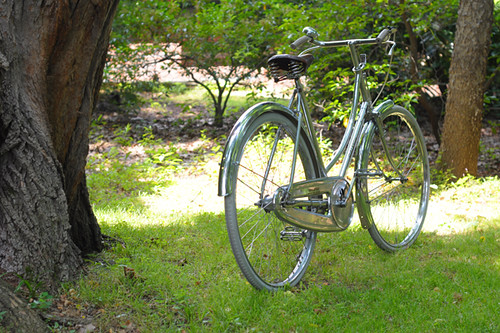
While this bicycle is rare by virtue of being unusual (I only know of two other lady's chrome DL-1s in existence - one of themhere), the late vintage and used condition don't make it especially valuable in collectors' terms. It is, however, historically significant - serving as an example of Raleigh's chrome finish and late-production DL-1 models. I can hardly believe my luck in getting my hands on one of these.
More information on chrome Raleighs can be found here. And a good source of information on DL-1s in general is the author of this blog. Also worth visiting is Velo Ulli's collection - his focus is on pre-1920s bikes and it's glorious eye candy. It's always good to know collectors whose interests are different from yours... that way they can pass those unwanted bikes they pick up onto you!
Wednesday, April 21, 2010
Rain, Rain Go Away? Or on Second Thought, Stay!
 I have not been cycling for the past week due to nonstop rain. But today I finally could not take it anymore: Despite the overcast sky and the morbid forecast, I went. By mid-day, it did rain. And it was great!
I have not been cycling for the past week due to nonstop rain. But today I finally could not take it anymore: Despite the overcast sky and the morbid forecast, I went. By mid-day, it did rain. And it was great!
Some nice things about cycling in the rain:
. it's good for your complexion
. you can sing in it (and I did!)
. the grass and trees look super green, almost neon
. the lovely scent of flowers really comes out
. you have the cycle paths mostly to yourself
. you have an excuse to wear screaming red and lobsterman yellow!
 Above: My empty Apfelspritzer mug, in an empty outdoor cafe -- in the rain. Look how red those geraniums look!
Above: My empty Apfelspritzer mug, in an empty outdoor cafe -- in the rain. Look how red those geraniums look!
Tuesday, April 20, 2010
Pinewood Estate

When I visited here last time, we did not go to see the house that is at Bok Tower Gardens. The house is named the Pinewood Estate and you can do a tour of this neat place. It is listed on the National Register of Historic Places.

A tour through the magnificent Mediterranean-style Pinewood Estate lets
you experience the luxurious lifestyle of C. Austin Buck, an early 20th
century industrialist. Mr. Buck was the vice president of Bethlehem Steel. The Estate occupies eight acres of Bok Tower Gardens and is enjoyed by thousands of visitors each year.

Pinewood Estate’s has beautiful gardens and a 20 room Mediterranean-style
mansion built in the early 1930s. It is considered one of the finest examples of
Mediterranean-style architecture in Florida.

Pinewood began its life in 1930 under the name “El Retiro”.
Frederick Law Olmsted Jr., who came to the area in 1922 to design Edward
W. Bok’s Gardens, was designing private gardens at nearby Mountain Lake
Estates. William Lyman Phillips was assigned as the Olmsted
representative and was retained by Buck to design the gardens and site
of “El Retiro” to take maximum advantage of the lush Florida landscape.

Charles Wait, long affiliated with the Olmsted firm, was brought in to
design the house in the Mediterranean-style Floridians still enjoy
today. Wait created a house that had the appearance of a Mediterranean
villa. The thick walls, wrought iron details, carved woodwork and doors
heighten the effect. Wait also incorporated large porches to give clear
views of the surroundings and provide constant air flow.

Buck, who admired Latin lifestyle and architecture, obtained the tiles
used throughout the house from Cuba. Phillips, who spent time in the
Canal Zone and had a great love for the tropics, set about creating a
series of vistas – a Spanish frog fountain leading to a grotto in front
of the house; an Oriental moon gate outside the dining room; and the
long view down a rolling lawn to the lily pool. The entire house was
situated to give views through the surrounding pine trees.

Over the years, Pinewood changed hands several times before it was
acquired by Bok Tower Gardens in 1970. The estate was restored to its
original design by nationally recognized restoration landscape architect
Rudy Favretti, the staff of Bok Tower Gardens and a corps of
volunteers. Today, work continues to preserve the mansion listed on the
National Register of Historic Places.
Subscribe to:
Posts (Atom)




